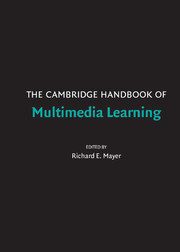Book contents
- Frontmatter
- Contents
- Preface
- Contributors
- 1 Introduction to Multimedia Learning
- PART I THEORETICAL FOUNDATIONS
- PART II BASIC PRINCIPLES OF MULTIMEDIA LEARNING
- PART III ADVANCED PRINCIPLES OF MULTIMEDIA LEARNING
- PART IV MULTIMEDIA LEARNING IN CONTENT AREAS
- PART V MULTIMEDIA LEARNING IN ADVANCED COMPUTER-BASED CONTEXTS
- 31 Multimedia Learning with Animated Pedagogical Agents
- 32 Multimedia Learning in Virtual Reality
- 33 Multimedia Learning in Games, Simulations, and Microworlds
- 34 Multimedia Learning with Hypermedia
- 35 Multimedia Learning in e-Courses
- Author Index
- Subject Index
- References
35 - Multimedia Learning in e-Courses
Published online by Cambridge University Press: 05 June 2012
- Frontmatter
- Contents
- Preface
- Contributors
- 1 Introduction to Multimedia Learning
- PART I THEORETICAL FOUNDATIONS
- PART II BASIC PRINCIPLES OF MULTIMEDIA LEARNING
- PART III ADVANCED PRINCIPLES OF MULTIMEDIA LEARNING
- PART IV MULTIMEDIA LEARNING IN CONTENT AREAS
- PART V MULTIMEDIA LEARNING IN ADVANCED COMPUTER-BASED CONTEXTS
- 31 Multimedia Learning with Animated Pedagogical Agents
- 32 Multimedia Learning in Virtual Reality
- 33 Multimedia Learning in Games, Simulations, and Microworlds
- 34 Multimedia Learning with Hypermedia
- 35 Multimedia Learning in e-Courses
- Author Index
- Subject Index
- References
Summary
Abstract
E-learning is on the rise in both the public and private sectors. However, learning outcomes are either flat or remain unknown. Therefore, it is important to ground e-learning design, development, and selection on the basis of credible evidence. Research on multimedia instruction in the last two decades has moved beyond “Which media is best?” studies to more productive questions regarding the best use of instructional methods that support cognitive learning processes. This chapter reviews research evidence on what we know about how best to use three unique media features that together distinguish e-learning from other delivery media: audio modality, animations, and simulations. In each case, evidence suggests that practitioners exploit unique media capabilities by applying guidelines for their use that accommodate the strengths and limits of human cognitive processes.
Introduction to E-Learning
Although still a distant second to classroom instruction, e-learning is steadily increasing in media market share as an instructional delivery alternative for learners from 5 to 85. Sixteen percent of instruction in business and industry was delivered by computer in 2003 – up from 12% the previous year (Galvin, 2003). Almost 90% of all universities with more than 10,000 students offer some form of distance learning – nearly all of which use the Internet (Svetcov, 2000). Public education has also invested heavily in information technology with multimedia computer ratios dropping from 21 students per computer in 1997 to fewer than 10 in 2000 (Cuban, 2001).
- Type
- Chapter
- Information
- The Cambridge Handbook of Multimedia Learning , pp. 589 - 616Publisher: Cambridge University PressPrint publication year: 2005
References
- 14
- Cited by

